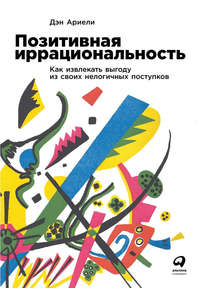
Полная версия
The Upside of Irrationality: The Unexpected Benefits of Defying Logic at Work and at Home
AND NOW FOR the journey…
Part I THE UNEXPECTED WAYS WE DEFY LOGIC AT WORK
CHAPTER 1 Paying More for Less
Why Big Bonuses Don’t Always Work
Imagine that you are a plump, happy laboratory rat. One day, a gloved human hand carefully picks you out of the comfy box you call home and places you into a different, less comfy box that contains a maze. Since you are naturally curious, you begin to wander around, whiskers twitching along the way. You quickly notice that some parts of the maze are black and others are white. You follow your nose into a white section. Nothing happens. Then you take a left turn into a black section. As soon as you enter, you feel a very nasty shock surge through your paws.
Every day for a week, you are placed in a different maze. The dangerous and safe places change daily, as do the colors of the walls and the strength of the shocks. Sometimes the sections that deliver a mild shock are colored red. Other times, the parts that deliver a particularly nasty shock are marked by polka dots. Sometimes the safe parts are covered with black-and-white checks. Each day, your job is to learn to navigate the maze by choosing the safest paths and avoiding the shocks (your reward for learning how to safely navigate the maze is that you aren’t shocked). How well do you do?
More than a century ago, psychologists Robert Yerkes and John Dodson* performed different versions of this basic experiment in an effort to find out two things about rats: how fast they could learn and, more important, what intensity of electric shocks would motivate them to learn fastest. We could easily assume that as the intensity of the shocks increased, so would the rats’ motivation to learn. When the shocks were very mild, the rats would simply mosey along, unmotivated by the occasional painless jolt. But as the intensity of the shocks and discomfort increased, the scientists thought, the rats would feel as though they were under enemy fire and would therefore be more motivated to learn more quickly. Following this logic we would assume that when the rats really wanted to avoid the most intense shocks, they would learn the fastest.
We are usually quick to assume that there is a link between the magnitude of the incentive and the ability to perform better. It seems reasonable that the more motivated we are to achieve something, the harder we will work to reach our goal, and that this increased effort will ultimately move us closer to our objective. This, after all, is part of the rationale behind paying stockbrokers and CEOs sky-high bonuses: offer people a very large bonus, and they will be motivated to work and perform at very high levels.
SOMETIMES OUR INTUITIONS about the links between motivation and performance (and, more generally, our behavior) are accurate; at other times, reality and intuition just don’t jibe. In Yerkes and Dodson’s case, some of the results aligned with what most of us might expect, while others did not. When the shocks were very weak, the rats were not very motivated, and, as a consequence, they learned slowly. When the shocks were of medium intensity, the rats were more motivated to quickly figure out the rules of the cage, and they learned faster. Up to this point, the results fit with our intuitions about the relationship between motivation and performance.
But here was the catch: when the shock intensity was very high, the rats performed worse! Admittedly, it is difficult to get inside a rat’s mind, but it seemed that when the intensity of the shocks was at its highest, the rats could not focus on anything other than their fear of the shock. Paralyzed by terror, they had trouble remembering which parts of the cage were safe and which were not and, so, were unable to figure out how their environment was structured.
The graph below shows three possible relationships between incentive (payment, shocks) and performance. The light gray line represents a simple relationship, where higher incentives always contribute in the same way to performance. The dashed gray line represents a diminishing-returns relationships between incentives and performance.
The solid dark line represents Yerkes and Dodson’s results. At lower levels of motivation, adding incentives helps to increase performance. But as the level of the base motivation increases, adding incentives can backfire and reduce performance, creating what psychologists often call an “inverse-U relationship.”

Yerkes and Dodson’s experiment should make us wonder about the real relationship between payment, motivation, and performance in the labor market. After all, their experiment clearly showed that incentives can be a double-edged sword. Up to a certain point, they motivate us to learn and perform well. But beyond that point, motivational pressure can be so high that it actually distracts an individual from concentrating on and carrying out a task—an undesirable outcome for anyone.
Of course, electric shocks are not very common incentive mechanisms in the real world, but this kind of relationship between motivation and performance might also apply to other types of motivation: whether the reward is being able to avoid an electrical shock or the financial rewards of making a large amount of money. Let’s imagine how Yerkes and Dodson’s results would look if they had used money instead of shocks (assuming that the rats actually wanted money). At small bonus levels, the rats would not care and not perform very well. At medium bonus levels, the rats would care more and perform better. But, at very high bonus levels, they would be “overmotivated.” They would find it hard to concentrate, and, as a consequence, their performance would be worse than if they were working for a smaller bonus.
So, would we see this inverse-U relationship between motivation and performance if we did an experiment using people instead of rats and used money as the motivator? Or, thinking about it from a more pragmatic angle, would it be financially efficient to pay people very high bonuses in order to get them to perform well?
The Bonus Bonanza
In light of the financial crisis of 2008 and the subsequent outrage over the continuing bonuses paid to many of those deemed responsible for it, many people wonder how incentives really affect CEOs and Wall Street executives. Corporate boards generally assume that very large performance-based bonuses will motivate CEOs to invest more effort in their jobs and that the increased effort will result in higher-quality output.* But is this really the case? Before you make up your mind, let’s see what the empirical evidence shows.
To test the effectiveness of financial incentives as a device for enhancing performance, Nina Mazar (a professor at the University of Toronto), Uri Gneezy (a professor at the University of California at San Diego), George Loewenstein (a professor at Carnegie Mellon University), and I set up an experiment. We varied the amount of financial bonuses participants could receive if they performed well and measured the effect that the different incentive levels had on performance. In particular, we wanted to see whether offering very large bonuses would increase performance, as we usually expect, or decrease performance, analogous to Yerkes and Dodson’s experiment with rats.
We decided to offer some participants the opportunity to earn a relatively small bonus (equivalent to about one day’s pay at their regular pay rate). Others would have a chance to earn a medium-sized bonus (equivalent to about two weeks’ pay at their regular rate). The fortunate few, and the most important group for our purposes, could earn a very large bonus, equal to about five months of their regular pay. By comparing the performances of these three groups, we hoped to get a better idea of how effective the bonuses were in improving performance.
I know you are thinking “Where can I sign up for this experiment?” But before you make extravagant assumptions about my research budget, let me tell you that we did what many companies are doing these days—we outsourced the operation to rural India, where the average person’s monthly spending was about 500 rupees (approximately $11). This allowed us to offer bonuses that were very meaningful to our participants without raising the eyebrows and ire of the university’s accounting system.
Once we decided where to run our experiments, we had to select the tasks themselves. We thought about using tasks that were based on pure effort, such as running, doing squats, or lifting weights, but since CEOs and other executives don’t earn their money by doing those kinds of things, we decided to focus on tasks that required creativity, concentration, memory, and problem-solving skills. After trying out a whole range of tasks on ourselves and on some students, the six tasks we selected were:
1 Packing Quarters: In this spatial puzzle, the participant had to fit nine quarter-circle wedges into a square. Fitting eight of them is simple, but fitting all nine is nearly impossible.
2 Simon: A bold-colored relic of the 1980s, this is (or was) a common electronic memory game requiring the participant to repeat increasingly longer sequences of lit-up colored buttons without error.
3 Recall Last Three Numbers: Just as it sounds, this is a simple game in which we read a sequence of numbers (23, 7, 65, 4, and so on) and stopped at a random moment. Participants had to repeat the last three numbers.
4 Labyrinth: A game in which the participant used two levers to control the angle of a playing surface covered with a maze and riddled with holes. The goal was to advance a small ball along a path and avoid the holes.
5 Dart Ball: A game much like darts but played with tennis balls covered with the looped side of Velcro and a target covered with the hooked side so that the balls would stick to it.
6 Roll-up: A game in which the participant moved two rods apart in order to move a small ball as high up as possible on an inclining slope.

Having chosen the games, we packed six of each type into a large box and shipped them to India. For some mysterious reason, the people at customs in India were not too happy with the battery-powered Simon games, but after we paid a 250 percent import tax, the games were released and we were ready to start our experiment.
We hired five graduate students in economics from Narayanan College in the southern Indian city of Madurai and asked them to go to a few of the local villages. In each of these, the students had to find a central public space, such as a small hospital or a meeting room, where they could set up shop and recruit participants for our experiment.
One of the locations was a community center, where Ramesh, a second-year master’s student, got to work. The community center was not fully finished, with no tiles on the floors and unpainted walls, but it was fully functional and, most important, it provided protection from wind, rain, and heat.
Ramesh positioned the six games around the room and then went outside to hail his first participant. Soon a man walked by, and Ramesh immediately tried to interest him in the experiment. “We have a few fun tasks here,” he explained to the man. “Would you be interested in participating in an experiment?” The deal sounded suspiciously like a government-sponsored activity to the passerby, so it wasn’t surprising that the fellow just shook his head and continued to walk on. But Ramesh persisted: “You can make some money in this experiment, and it’s sponsored by the university.” And so our first participant, whose name was Nitin, turned around and followed Ramesh into the community center.
Ramesh showed Nitin all the tasks that were set up around the room. “These are the games we will play today,” he told Nitin. “They should take about an hour. Before we start, let’s find out how much you could get paid.” Ramesh then rolled a die. It landed on 4, which according to our randomization process placed Nitin in the medium-level bonus condition, which meant that the total bonus he could make from all six games was 240 rupees—or about two weeks’ worth of pay for the average person in this part of rural India.
Next, Ramesh explained the instructions to Nitin. “For each of the six games,” he said, “we have a medium level of performance we call good and a high level of performance we call very good. For each game in which you reach the good level of performance, you will get twenty rupees, and for each game in which you reach the very good level of performance you will get forty rupees. In games in which you don’t even reach the good level, you will get nothing. This means that your payment will be somewhere between zero rupees and two hundred forty rupees, depending on your performance.”
Nitin nodded, and Ramesh picked the Simon game at random. In this game, one of the four colored buttons lights up and plays a single musical tone. Nitin was supposed to press the lighted button. Then the device would light the same button followed by another one; Nitin would press those two buttons in succession; and so on through an increasing number of buttons. As long as Nitin remembered the sequence and didn’t make any mistakes, the game kept going and the length of the sequence increased. But once Nitin got a sequence wrong, the game would end and Nitin’s score would be equal to his largest correct sequence. In total, Nitin was allowed ten tries to reach the desired score.
“Now let me tell you what good and very good mean in this game,” Ramesh continued. “If you manage to correctly repeat a sequence of six steps on at least one of the ten times you play, that’s a good level of performance and will earn you twenty rupees. If you correctly repeat a sequence of eight steps, that’s a very good level of performance and you will get forty rupees. After ten attempts, we will begin the next game. Is everything clear about the game and the rules for payment?”
Nitin was quite excited about the prospect of earning so much money. “Let’s start,” he said, and so they did.
The blue button was the first to light up, and Nitin pressed it. Next came the yellow button, and Nitin pressed the blue and yellow buttons in turn. Not so hard. He did fine when the green button lit up next but unfortunately failed on the fourth button. In the next game, he did not do much better. In the fifth game, however, he remembered a sequence of seven, and in the sixth game he managed to get a sequence of eight. Overall, the game was a success, and he was now 40 rupees richer.
The next game was Packing Quarters, followed by Recall Last Three Numbers, Labyrinth, Dart Ball, and finally Roll-up. By the end of the hour, Nitin had reached a very good performance level on two of the games and a good performance level on two others. But he failed to reach the good level of performance for two of the games. In total, he made 120 rupees—a little more than a week’s pay—so he walked out of the community center a delighted man.
The next participant was Apurve, an athletic and slightly balding man in his thirties and the proud father of twins. Apurve rolled the die and it landed on 1, a number that, according to our randomization process, placed Apurve in the low-level bonus condition. This meant that the total bonus he could make from all six games was 24 rupees, or about one day of pay.
The first game Apurve played was Recall Last Three Numbers, followed by Roll-up, Packing Quarters, Labyrinth, and Simon, and ending with Dart Ball. Overall, he did rather well. He reached a good performance level in three of the games and a very good performance level in one. This put him on more or less the same performance level as Nitin, but, thanks to the unlucky roll of the die, he made only 10 rupees. Still, he was happy to receive that amount for an hour of playing games.
When Ramesh rolled the die for the third participant, Anoopum, it landed on 5. According to our randomization process, this placed him in the highest-level bonus condition. Ramesh explained to Anoopum that for each game in which he reached the good level of performance he would be paid 200 rupees and that he would receive 400 rupees for each game in which he reached the very good score. Anoopum made a quick calculation: six games multiplied by 400 rupees equaled 2,400 rupees—a veritable fortune, roughly equivalent to five months’ pay. Anoopum couldn’t believe his good luck.
The first randomly selected game for Anoopum was Labyrinth.* Anoopum was instructed to place a small steel ball at the start position and then use the two knobs to advance the small ball through the maze while helping it avoid the trap holes. “We’ll play this game ten times,” Ramesh said. “If you manage to advance the ball past the seventh hole, we’ll call this a good level of performance, for which you will be paid two hundred rupees. If you manage to advance the ball past the ninth hole, we’ll call that a very good level of performance, and you will get four hundred rupees. When we’ve finished with this game, we’ll go on to the next. Everything clear?”
Anoopum nodded eagerly. He grabbed the two knobs that controlled the tilt of the maze surface and stared at the steel ball in its “start” position as if it were prey. “This is very, very important,” he mumbled. “I must succeed.”
He set the ball rolling; almost immediately, it fell into the first trap. “Nine more chances,” he said aloud to encourage himself. But he was under the gun, and his hands were now trembling. Unable to control the fine movements of his hands, he failed time after time. Having flubbed Labyrinth, he saw the wonderful images of what he would do with his small fortune slowly dissolve.
The next game was Dart Ball. Standing twenty feet away, Anoopum tried to hit the Velcro center of the target. He hurled one ball after another, throwing one from below like a softball pitch, another from above as in cricket, and even from the side. Some of the balls came very close to the target, but none of his twenty throws stuck to the center.
The Packing Quarters game was sheer frustration. In a minuscule two minutes, Anoopum had to fit the nine pieces into the puzzle in order to earn 400 rupees (if he took four minutes, he could earn 200 rupees). As the clock ticked, Ramesh read out the remaining time every thirty seconds: “Ninety seconds! Sixty seconds! Thirty seconds!” Poor Anoopum tried to work faster and faster, applying more and more force to fit all nine of the wedges into the square, but to no avail.
At the end of the four minutes, the Packing Quarters game was abandoned. Ramesh and Anoopum moved on to the Simon game. Anoopum felt somewhat frustrated, but he braced himself and tried his utmost to focus on the task at hand.
His first attempt with Simon resulted in a two-light sequence—not very promising. But, on the second try, he managed to recall a sequence of six. He beamed, because he knew that he had finally made at least 200 rupees, and he had eight more chances to make it to 400. Feeling as though he was finally able to do something well, he tried to increase his concentration, willing his memory to a higher plane of performance. In the next eight attempts, he was able to remember sequences of six and seven, but he never made it to eight.
With two more games to go, Anoopum decided to take a short break. He went through calming breathing exercises, exhaling a long “Om” with each breath. After several minutes, he felt ready for the Roll-up game. Unfortunately, he failed both the Roll-up game and the Recall Last Three Numbers task. As he left the community center, he comforted himself with the thought of the 200 rupees he had earned—a nice sum for a few games—but his frustration at not having gotten the larger sum was evident on his furrowed brow.
The Results: Drumroll, Please…
After a few weeks, Ramesh and the other four graduate students finished the data collection in a number of villages and mailed me the performance records. I was very eager to take a first look at the results. Was our Indian experiment worth the time and effort? Would the different levels of bonuses tally with the levels of performance? Would those who could receive the highest bonuses perform better? Worse?
For me, taking a first peek into a data set is one of the most exciting experiences in research. Though it’s not quite as thrilling as, say, catching a first glimpse of one’s child on an ultrasound, it’s easily more wonderful than opening a birthday present. In fact, for me there’s a ceremonial aspect to viewing a first set of statistical analysis. Early on in my research career, after having spent weeks or months of collecting data, I would enter all the numbers into a data set and format it for statistical analysis. Weeks and months of work would bring me to the point of discovery, and I wanted to be sure to celebrate the moment. I would take a break and pour myself a glass of wine or make a cup of tea. Only then would I sit down to celebrate the magical moment when the solution to the experimental puzzle I had been working on was finally revealed.
That magical moment is infrequent for me these days. Now that I’m no longer a student, my calendar is filled with commitments and I no longer have time to analyze experimental data myself. So, under normal circumstances, my students or collaborators take the first pass at the data analysis and experience the rewarding moment themselves. But when the data from India arrived, I was itching to have this experience once again. So I persuaded Nina to give me the data set and made her promise that she would not look at the data while I worked on it. Nina promised, and I reinstated my data analysis ritual, wine and all.
BEFORE I TELL you the results, how well do you think the participants in the three groups did? Would you guess that those who could earn a medium-level bonus did better than those who were faced with the small one? Do you think those hoping for a very large bonus did better than those who could achieve a medium-level one? We found that those who could earn a small bonus (equivalent to one day of pay) and the medium-level bonus (equivalent to two weeks’ worth of work) did not differ much from each other. We concluded that since even our small payment was worth a substantial amount to our participants, it probably already maximized their motivation. But how did they perform when the very large bonus (the amount equivalent to five months of their regular pay rate) was on the line? As you can tell from the figure above, the data from our experiment showed that people, at least in this regard, are very much like rats. Those who stood to earn the most demonstrated the lowest level of performance. Relative to those in the low-or medium-bonus conditions, they achieved good or very good performance less than a third of the time. The experience was so stressful to those in the very-large-bonus condition that they choked under the pressure, much like the rats in the Yerkes and Dodson experiment.
The graph below summarizes the results for the three bonus conditions across the six games. The “very good” line represents the percentage of people in each condition who achieved this level of performance. The “earnings” line represents the percentage of total payoff that people in each condition earned.

Supersizing the Incentive
I should probably tell you now that we didn’t start out running our experiments in the way I just described. Initially, we set about to place some extra stress on our participants. Given our limited research budget, we wanted to create the strongest incentive we could with the fixed amount of money we had. We chose to do this by adding the force of loss aversion to the mix.* Loss aversion is the simple idea that the misery produced by losing something that we feel is ours—say, money—outweighs the happiness of gaining the same amount of money. For example, think about how happy you would be if one day you discovered that due to a very lucky investment, your portfolio had increased by 5 percent. Contrast that fortunate feeling to the misery that you would feel if, on another day, you discovered that due to a very unlucky investment, your portfolio had decreased by 5 percent. If your unhappiness with the loss would be higher than the happiness with the gain, you are susceptible to loss aversion. (Don’t worry; most of us are.)








